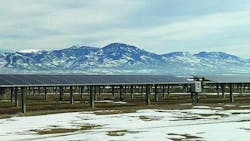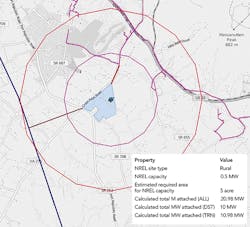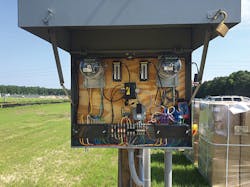PV: An Opportunity and a Challenge
For Dominion Virginia Power, the impact of solar energy on its electric transmission and distribution system is real. The aggregate number of solar projects in Virginia, North Carolina and PJM is increasing in record numbers. Likewise, the connected power from
solar installations in the U.S. is continuing to set records. With increasing solar photovoltaics (PV) penetration connected to the distribution system, power flows from the distribution system back onto the transmission grid — a first for Dominion. This reverse flow is happening at multiple locations on peak and non-peak days.
Like other utilities, Dominion’s classically radial distribution system is starting to behave like a networked system. In general, distribution systems were not designed to operate in backfeed mode, and utilities like Dominion are working to address the associated technical complexities. Dominion, which serves 2.5 million customers in Virginia and northeastern North Carolina, has approached solar integration proactively to ensure safety, acceptance and economic viability. The unprecedented solar growth in the Dominion service territory, particularly in North Carolina, has precipitated new processes, procedures and collaborations.
Solar Market Growth
Earlier this year, Dominion was ranked by the Smart Electric Power Alliance as a top 10 solar utility in 2015. The utility has more than 400 MW of connected T&D solar installations in Virginia and northeastern North Carolina, as well as solar generation facilities in eight states. While rooftop solar is prevalent in other parts of the U.S., utility-scale solar (1 MW and above) dominates the North Carolina market. Tax incentives offered by North Carolina were among the factors that made solar attractive to developers, but they also are what challenged traditional electric infrastructure to accommodate the significant influx of renewable generation. The incentives expired at the end of 2015.
The solar market continues to grow in Virginia, as well. In addition to new interconnection requests in the queues, Dominion is leading by example and driving solar growth in Virginia. The Virginia State Corporation Commission approved Dominion’s application in June 2016 to construct and operate three solar facilities. The construction of a 17-MW facility in Powhatan County, 20-MW facility in Louisa County and 19-MW facility in Isle of Wight County will be completed by December 2016. These facilities will produce about 124 GW of electricity annually. In August 2016, Dominion, the U.S. Department of the Navy and the Commonwealth of Virginia announced they are partnering on a 21-MW solar facility at the Naval Air Station Oceana in Virginia Beach.
Interconnection Studies
PJM, the regional transmission organization that coordinates the movement of wholesale electricity across 13 states and the District of Columbia, including the Dominion service area, is including distribution-connected solar in its forecasts. Dominion performs the facility impact studies associated with the PJM Interconnection queue — all transmission interconnections and distribution interconnections governed by the Federal Energy Regulatory Commission jurisdiction — as well as administers the full interconnection process of two state queues — distribution interconnections in Virginia and North Carolina. Customized interconnection studies are performed for each interconnection request to address the safety, reliability and operability of the grid for all customers.
Dominion is working with PJM to analyze the impact of the injection of distribution generation and loss of distribution load on its bulk power system. The potential for line overloading continues to increase as solar capacity increases, adding to the importance of the work planners do every day to balance load.
Trend Tracking
Because solar is an intermittent generation, applying traditional planning tools can be tricky. One of the challenges presented by solar installations is that while generating power, this technology typically does not provide the standard voltage regulation or frequency response conventional generation facilities have traditionally provided. While some smart inverters offer advanced inverter functions, prescribing, managing and controlling the intelligence of smart inverters over a wide area comes with challenges Dominion is exploring. The utility considers the use of inverter settings to address operational issues in conjunction with required upgrades to the grid in accordance with good utility practice.
PJM recently added new interconnection requirements stating that non-synchronous generators (such as solar and wind) requesting interconnection after May 2015 must have “enhanced inverter capabilities.” However, the generation interconnections administered by the state queue are not yet required to follow similar requirements.
Dominion developed a set of dashboards to aid in the understanding and analysis of solar installations. Launched in February 2016, the dashboards pull information from a diverse set of databases, enabling Dominion staff to view the latest data from every connected solar site in real time and explore theoretical solar installations across Dominion’s electric grid. These dashboards have demonstrated the off and on variability of solar — from individual sites to systemwide aggregation — and helped the utility to visualize and study theoretical large-scale deployments of solar across Virginia and North Carolina. Engineers are able to understand historical and real-time impacts of solar while also preparing for the future.
Taskforces and Guidelines
Dominion also has assembled several internal working groups to address interconnection processes and procedures as well as to offer guidance. Dominion’s operations engineering team, which recently conducted a comprehensive solar integration study to evaluate the impact on the Dominion system, is working on a final report that will provide valuable insights. Similarly, Dominion’s electric transmission PV integration task force transitioned into a working group last year, expanding its focus to address PV concerns as they pertain to transmission and distribution. The group now has members from across both organizations.
This cross-functional task force, which meets monthly, has helped to identify subject-matter experts and set policies that have yielded great process improvements for Dominion. For example, the task force recommended a detailed document outlining protection requirements for all generator interconnections to the Dominion system. As a result, the Dominion’s system protection engineering team has developed the first such document within the PJM Interconnection service area with requirements for wide area protection, local area protection, power-quality monitoring, data communications and data exchange.
Dominion also has developed guidelines that outline the defining characteristics of interconnection request modifications, which may affect a prospective project’s position in the interconnection queue. These material modification guidelines are streamlining the request process for new solar installations, significantly reducing the need for multiple re-studies (potentially as a result of solar developers changing parameters of their queue requests), reducing the backlog of requests and bringing efficiencies to the dialog between Dominion and generation developers seeking interconnection.
In addition, Dominion has developed protection and data monitoring standards, such as standardized protection and metering instrumentation equipment for solar installations. Dominion’s distribution planning group also has developed a well-defined commissioning and witness testing procedure, which has improved the solar plant energization process.
Partnerships and Collaboration
Open communication is an important aspect of any successful partnership. Dominion’s system protection engineering team participates in several industry organizations. Examples of this industry cooperation and collaboration include companies and societies within the IEEE in the midst of a full rewrite of both the 1547 standard on interconnecting distributed resources with electric power systems and the 1547.1 standard on conformance test procedures for equipment interconnecting distributed resources with electric power systems. This collaboration has fostered interactions with forums such as the Forum on Inverter Grid Integration Issues, an ad-hoc working group comprised of solar manufacturers, engineers and other industry experts.
The IEEE Standards Association Conformity Assessment program has launched an effort in support of the IEEE 1547/1547.1 standards activities to further define and refine conformity to these established standards. The power system relay and control committee also sponsors activities related to the technical detail, protection, control and integration of generation resources to the grid.
Working within and alongside these technical organizations, Dominion expects these efforts will result in well-thought-out interconnection requirements that will lead to a safe and reliable integration of a broad portfolio of energy resources into the electric power system.
Dominion employees also have reached out to their counterparts at peer utilities to learn more. The distributed generation working group, which is comprised of members from some of the top U.S. utilities, meets twice a year to discuss technical issues, standards and lessons learned. The working group also exchanges information through emails and phone calls in between meetings and collaborates on presentations at industry events. Engineers from participating utilities share their practices with inverter equipment, protective devices and applications. In this way, the group continually shares lessons learned associated with solar integration.
Dominion also has begun inviting manufacturers to interact with its engineers about the advancement of technologies that are under development. These information-sharing sessions are formatted to educate and inform engineers, so they are able to understand how currently marketed and upcoming technologies can benefit Dominion, its customers and its partners. The manufacturers also gain knowledge about Dominion’s needs. This practice has paid off for Dominion and has led to new standards for interconnections and several pilot projects oriented toward improving the safety of the grid in the presence of high-penetration solar generation.
Looking Forward
With the growth of solar generation on the rise, Dominion will remain focused on improving network integration. Despite their best efforts, utilities are still left with the many unknown impacts — both technical and financial — of PV. Dominion continues to look carefully at planning techniques and models to assess the operational impacts these variable, nondispatchable, inverter-based generation sources inject.
Ongoing studies and analyses by employees as well as with community and industry partners will ensure successful integration while maintaining the overall integrity of the electrical grid.
Luis Vega is supervisor of Dominion Virginia Power’s power-quality group. His group focuses on how the delivery and use of electricity affects residential, commercial and industrial customers’ production, operation, or lifestyle. During his 15 years at Dominion, he has worked in design, coordination, distribution planning, reliability and operations. Vega holds a BSME degree from Virginia Commonwealth University and a MBA degree from Averett University.
Mutmainna Tania is a consulting engineer in Dominion Virginia Power’s integrated resource planning group. She has been at Dominion for more than five years and has worked in the electric transmission planning, system protection engineering and operations engineering research groups. She also has led a technical sub-team of the electric transmission photovoltaics integration task force. Her experience in the industry includes solar inverter integration, FACTS devices, system protection, adaptive relaying using synchrophasors and system restoration studies. She received her MSEE degree and doctorate degree in electrical engineering, specializing in power systems, from Virginia Tech.




